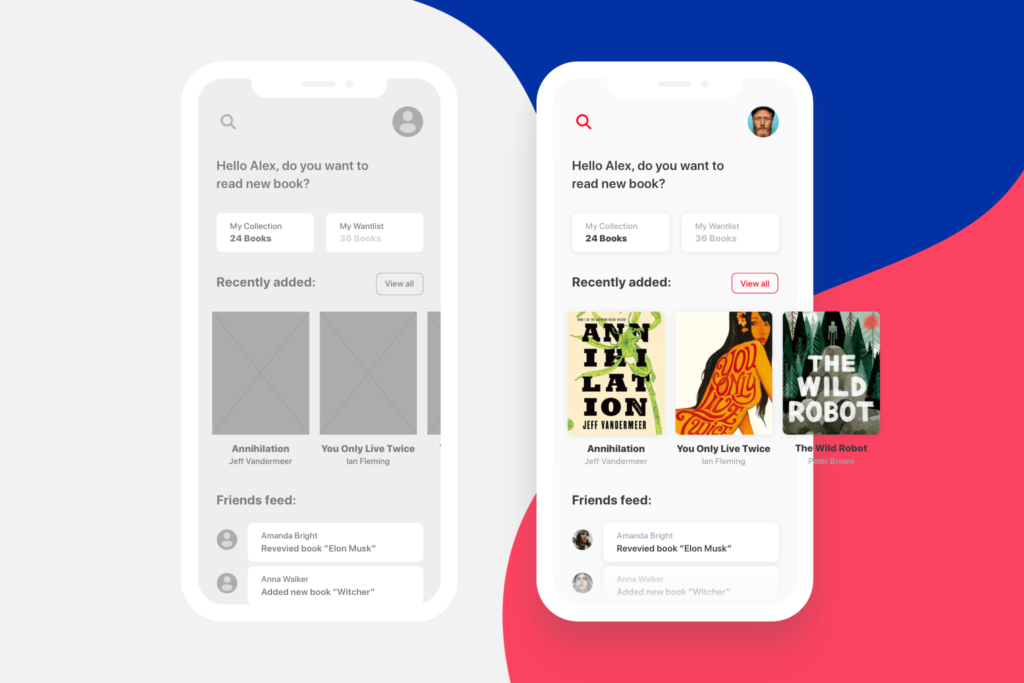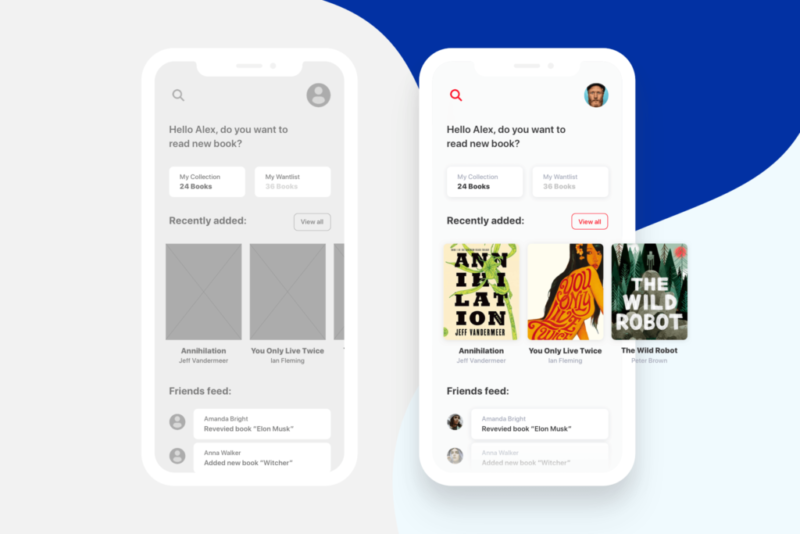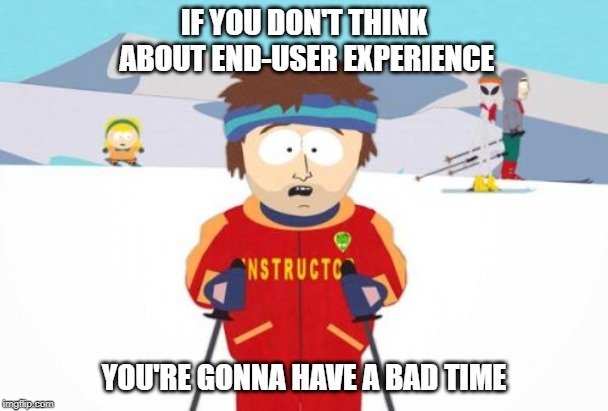09 May 2019
A designer explains: What’s the difference between UX and UI design in software development?

People tend to mix UX and UI terms. So, in this article, I’ll tell you about what’s the difference between UX and UI design and why having a really good designer in your project is priceless.
Lately, our CTO wrote an article comparing software development to a construction site. Well, if the code is the building structure (foundations, floors, and walls), then the user interface is furniture and appeal, and the user experience is the way we move and operate around the house.
Good UX/UI is invisible – if something is done right, you’ll never notice it. But if there’s something wrong, users will spot it in a matter of seconds (and surely get frustrated).
What is UX design?
It’s always good to start with a little bit of history. The term “user experience” was invented by Don Norman in the late 1990s. According to the researcher:
Regardless of the medium, the UX “encompasses all aspects of the end user’s interaction with the company, its services, and its products.”
To be fair, this definition is just as relevant today, as it was 20 years ago. User experience design is a process of establishing what users need and how to address those needs. There’s a variety of factors to be considered – user profile, working environment and interactions within, intuitive reactions, emotions, type of industry, the goal of product/service, etc. When as many variables as possible are designated, designers responsible for UX create a prototype – often in a few different versions.
The next step is validation. Through detailed testing, the creators decide whether business requirements and customers’ expectations were met. If not, the product has to be re-designed accordingly and re-tested again.
As you can see, designer responsible for UX is a quite complex position – at the same time they are designers, marketers, project managers, psychologists, researches…
The list of UX-related duties is quite long, including competition and customer analysis, product strategy planning, journey mapping, wireframing, prototyping, usability and A/B testing, cooperating with UI designers, developers and copywriters, and much more.
All this in order to create a positive experience for end-users, because their feelings towards, let’s say, application, can be transferred to the brand itself.
Utility, ease of use, performance, efficiency – designers who take care of UX must bear in mind multiple aspects when creating a user-friendly solution. That means the navigation has to be, foremost, intuitive.
See also: How to make applications more accessible 👇
Let’s use a food-ordering app as an example. If a first-time user doesn’t know how to create an account, connect a credit card, place an order or change a payment method straight away – then there’s definitely something wrong with the overall user experience. You can have the best products on the planet, but once you discourage a (potential) client on a complicated usability level, they might never come back to buy from you again.
What does UX and UI mean?
If UX is the usability, then the user interface is its visual presentation – how the app feels, looks like and how it cooperates with the end-user. It is also a direct translation of a brand and how it communicates with its clients. UI transfers brand’s visual communication, emphasises its characteristic elements and therefore strengthens UX itself.
UI design is a process of smoothly guiding the user through app’s possibilities by using an interactive interface (compatible with a given platform), content (texts, images, videos, illustrations, animations), shapes (buttons, checkboxes), and actions (what happens after clicking, typing, dragging, tapping or swiping certain elements).
A good user interface should have a clean design, understandable flow, simple navigation, familiar symbols, efficient responsiveness, feel-good aesthetics, and many more.
Similarly to UX designer, UI specialist is a complex job but with a straightforward goal – to make the app look and feel right. In order to achieve that, UI designers must conduct the following tasks: customer and trends analysis, branding, graphics research and development, interactivity, UI prototyping, animation, adjusting to all device and screen sizes, cooperation with UX designers and developers.
As you can see, some User Experience and User Interface designers responsibilities and goals intertwine. It shouldn’t be that surprising since everybody has the same goal – creating a user-friendly product. Since you already have a basic knowledge of what’s what, let’s discuss what are the biggest differences between them.

Is UI part of UX?
User Experience and User Interface are NOT the same things – even though sometimes they seem to overlap. So, what is the difference between UI and UX? To paint a better picture, I’ll use the example of an aforementioned generic food-ordering app. It will be easier to describe and understand certain processes.
User Experience vs User Interface
UX goes first, UI second. User experience establishes how the app works and user interface how it looks. Therefore, it seems logical that UX design has to be executed first. After the UX designer plans logic and architecture of the app, the UI designer can take over and implement visuals based on UX assumptions.
What users want?
UX designer has to adopt an extremely user-centric approach. They figure out what are the users’ priorities, what they like, what they avoid, what’s (not) intuitive for them, what they expect and what needs to be included/excluded from the app to satisfy users’ needs.
When all aforementioned points are settled and tested, the project is passed to UI designers along with a complete set of flows. Based on them, UI designers create user-friendly interface ensuring proper presentation.
Macro UX and micro UI
All designers take care of interactions. The difference is that the UX designer does it on a macro scale (the whole application flow allowing the user to create an account, browse the restaurants, place an order, pay and follow his delivery) while the UI designer takes care of micro-steps that help the user navigate through app’s elements (colour palette, fonts, symbols or these simple, almost unnoticeable animations which you see when pressing a button – so you know that the action has been made).
Beautiful usability
Like I’ve mentioned before, UX makes things usable and UI makes them pretty. In other words, UX allows you to perform certain actions (e.g. ordering lunch from a nearest Chinese restaurant) and UI helps you to perform them through a compelling interface (e.g. the “Place order” button is clearly visible and big enough for your finger to tap on it with no problems, no matter what device you’re using).
Why UX and UI design are important in software development?
During my time as a designer, I’ve met multiple clients who wanted to omit the planning phase and making mock-ups. They’d rather just develop the app straight away, believing that “this whole design mumbo jumbo” is unnecessary from the business point of view. No sugar coating – such an approach is just irresponsible.
UX is strictly business-related and focuses directly on the future user.
During scoping sessions, we analyse whether an MVP (minimal viable product – the first version of the product that examines the market) agrees with the business model and whether it is able to achieve business goals and solve or eliminate problems.
What some people don’t realise is that proper preparation will actually save you money and time in a long run – later, you won’t need to correct simple and avoidable mistakes that could have been spotted early on during scoping sessions.
What’s more, on a very early stage, designers can prepare design systems – elements that developers can freely move from one place to another without engaging designers later.

Even after the product has been implemented, UX and UI people can still help you. Designers can improve your app’s conversion rate by recomposing elements, parts, colours, etc., therefore making it even easier for the user to interact with the application.
Finally, it’s the work experience. UI designer knows that the “x” marks the spot where you close the window (or hide the treasure!🤫). So if you use the “x” symbol for starting the video, confirmation or anything else really, you’ll confuse the hell out of your user (very often on a subconscious level).
This is a pretty simple example, but both groups of designers make the product “feel” easy-to-use and appealing to the user. And believe me, you don’t want to put a price on an impression – like I’ve said before, even if you have the best products with the best prices, and you discourage the users on such a basic level as navigating through your app/website/whatever – you can (and you will at some extent) lose them forever.
We as users want to be comfortable, and when something becomes too difficult, we just pick something else – something that’s not overcomplicated.
Eventually, a flawless product must include both. Without UI, your product will have optimised architecture but completely lack visual communication and the “eye-candy” effect. Without UX, your app will be a work of art – but a completely useless one.
UX and UI designers at The Software House love good design!
At The Software House, Quality Assurance Engineers are not the only ones who thoroughly test the products we create. We made absolutely sure that the UX and UI designers are also involved in the process from its very beginning. We’ve built an experienced product design team because we strongly believe that designing equals problem-solving. Our team includes 12 design experts specialising in UX design, UI design, illustration and product design.
Our main business practice states that we not only implement the product, but we also take care of it.
You have to realise that product development is a constant process and there’s always a room for improvement. Trends change, users’ habits and needs change, technology changes – in that business environment, you can’t be static.
So, now you know the difference between User Experience and User Interface. If you want to feel the difference in your web/mobile application, platform or other service but you don’t know where to start – feel free to give us a shout!
Follow our designers on Dribbble and show them some love! ❤
Would you like to work in an experienced team of designers? 👨🏼💻
Check out our current job openings and apply now 👇

